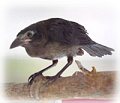


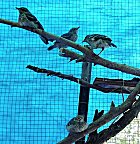
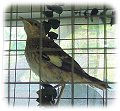
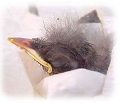
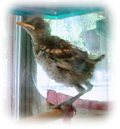
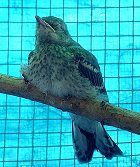 | Food
Nestlings require frequent feedings-- as much as every 30 minutes from dawn to dark. One person should take care of the bird to avoid excessive human contact. ( Don't tame the bird! ). Food should be at room temperature and of soft consistency. The bird shouldn't need water if the food is fairly moist.
Begin feeding young birds with an eyedropper. Fill the dropper so there are no air bubbles. If the bird won't open its mouth when food is presented, gently open the beak by slipping a fingernail between the upper and lower jaws and prying them apart. Put the dropper in the back of the bird's throat, behind the tongue, and slowly squeeze the dropper. Be careful not to get fluid in the breathing tube in the floor of the mouth just behind the tongue. Clean food from the beak and feathers with a moist tissue.
Later the bird will take thicker food and will eventually open the beak when it sees food or it may even squawk when it wants food. Stick the food to the end of a pointed popsicle stick or a drinking straw cut on a slant and give it to the bird. Do not use metal tweezers as they may damage the bird's tender mouth. As the bird grows it will eat more, but less frequently.
Birds have a high metabolic rate and a high energy requirement. Bread crumbs and milk are not sufficient. Most baby birds are unable to feed themselves; normally the parents feed them, so putting bird seeds or worms in the box does no good. You have to put the food into the baby. At first you may have to pry open the beak to do this, but soon the bird will realize that you are the source of food ( mama ) and will open its beak and squawk whenever it is hungry or when it hears you approach. Feed it when it asks for it. When it has enough it will collapse and sleep until it is hungry again.
A warning: be VERY CAREFUL not to get any food underneath his tongue. That is where his airway is and if food gets lodged in there he will choke. When he opens his beak, just make sure that you take your time to put the food above his tongue, preferably near the roof of his mouth. Just relax and don't worry about making a mess, because baby birds are very messy.
The majority of birds can be classified in two groups: meat eaters and seed eaters. Basic diets for these are listed below with suggestions for special foods for different species of birds. The sooner you identify the bird, the sooner you can provide the best diet. The basic foods mentioned in these diets can be classified into two groups:
MEAT: high protein dry kitten food (soaked in water), boiled chicken, live insects such as flies and mealworms.
GRAIN: high protein dry baby cereal , wheat germ, corn or oat meal that has been powdered down in a blender.
A good pinch of VET-NUTRI, a Squib vitamin/mineral supplement available at most veterinarians, should be added to each new batch of food you mix. Sprinkle over and mix in. Mix food daily; never mix more than you can use in a day's time. Otherwise it may sour. Supplement these basic diets with frequent little goodies whenever possible. Normal diets are listed below, so use your imagination. Those occasional tidbits of natural food help. Remember that young birds eat large amounts of food and at frequent intervals. Some consume an amount equal to their own weight each day. Just leaving food in the box or feeding two or three times a day is not enough! |
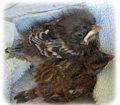
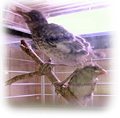
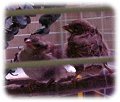

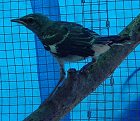 | Common Misconceptions
All Birds eat Worms
Although some birds do eat worms, best example the American Robin, most birds cannot handle the parasites associated with them.
Baby birds that have been touched by humans will be abandoned by their parents
As far as songbirds are concerned, they have a very poor sense of smell and will return to young as soon as we humans leave them be.
Give baby birds water so they don't get dehydrated
Never give a baby bird water alone as they cannot close their airway to allow it to pass into their crops. They drown easily and their air sacks are very susceptible to bacterial infections. Moisten bread for a temporary solution, pieces of fruit or mix a baby bird mash into a paste with water and place it in the crop with a 1cc syringe, without the needle. They will gape for vibration or peeping sounds. Insert the syringe in past the windpipe and inject it slowly into the crop. If any backs up into the throat, clear it with a Q-Tip. The windpipe is the hole directly behind their tongue.
Birds imprinted on humans should never be released
A bird that has imprinted on people is at a definite disadvantage for the first few weeks of freedom. Any that outlast these weeks have as good a chance as any other. You still have to supplement the diet of a freed bird at regular intervals through the day, they will learn to forage and will imprint on it's own kind in time.
My cat brought us a bird, but I rescued it and it is fine
Many times a bird that has suffered a cat or other animal attack appears fine at first but dies within 24 hours of the attack. This is usually due to a bacterial infection caused by the animal's saliva. Birds may be in great condition a day after an attack, only to die an hour later.
The wounds should be treated even though the bird appears to be doing OK. Internal as well as external antibiotic treatment continued for at least 3 days may work. Try Hibitane Veterinary Ointment on the wounds once a day and administer 1 drop of Chlor Palm 125 twice daily for three days and and you may save them. |



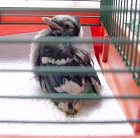
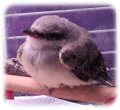



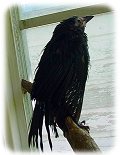 | A few birds you may find and what they eat
Flycatcher - Phoebe - Pewee
( normal diet is insects, some fruit ). Feed insect eater diet.
One that works is straight P/D dog food mixed with hard boiled egg yolk, dried flies, crushed mealworms and pupae (remove heads) Supplement with bits of non-citrus fruits pyracantha berries.
Grosbeak - Finch - Sparrow - Goldfinch - Towhee - Junco
( normal diet is seeds and insects. ) Feed insect eater diet
A successful mix is: one ounce GRAIN mixed with water, and one teaspoon strained beef baby food, and one thin slice of banana. Supplement diet with mealworms.
Hawk - Owl - Vulture - Eagle - Falcon
(normal diet is rodents, birds, insects, other small mammals).
Up to the age of one week, feed pink, hairless rat babies. Don't use rat heads or stomachs (the stomach will be white and full of milk). Chop up the rest of carcass into bite size pieces, probably match-head size, and feed everything to the bird. When the youngster is 2 to 3 weeks old, use older rats, but no heads or stomachs. You should skin the rats. Feed everything including bones. When the bird is 4 weeks old, it can have whole bodies of mice and some of the fur. Fur for casting material is NOT necessary.
Hummingbird
(normal diet is nectar, aphids, small insects, spiders).
4 parts boiled water to 1 part granulated sugar, plus mockingbird food (pet stores), Esbilac (bitch's milk supplement available from pet stores), mealworm innards. Good mix is: 2 cups water, 1/2 cup sugar, 20 squeezed mealworm insides, 1 tsp mocking bird food, 1 tblsp. Esbilac, a pinch VET-NUTRI.
Jay - Magpie - Crow - Raven - Starling
(normal diet is omnivorous). Feed insect eater diet
Supplement diet with mealworms, water-soaked currents or raisins, bits of non-citrus fruits, and berries such as pyracantha. Also sun flower seeds, peanuts (without the shell). Also occasional bits of chopped rat or mouse.
Killdeer
(normal diet is insects and worms).
Killdeer leave the nest soon after they hatch and feed independently, under the watchful eye of the parents. Usually "rescued" killdeer are picked up on a lawn and the finder assumes they are orphaned. Best thing to do is put them back and wait for the mother to call them to her. Keep in a box with a light. Put in a shallow dish of water; drop globs of tubifex worms (get at fish stores) into the water. Killdeer will eat them voraciously. Add mealworms later.
Meadowlark - Blackbird - Oriole - Woodpecker - Shrike - Bluebird Thrush - Robin - Waxwing
(normal diet insects, fruits, seeds). Feed insect eater diet Supplement with mealworms, water-soaked currents, raisins, bits of non-citrus fruits and berries such as pyracantha. SAPSUCKERS do not do well on whole crushed mealworms. It's better to give them wax worms (check with a bee keeper), crickets, crushed mealworms. You can also supplement them with HUMMINGBIRD FORMULA.
Mockingbird - Thrasher - Nuthatch - Titmouse - Chickadee
(normal diet is insects, seeds, berries). Feed insect eater diet Suggestion: straight P/D dog food mixed with hardboiled egg yolk dried flies, crushed mealworms, and pupae (remove heads). Supplement with bits of non-citrus fruits, such as the pyracantha berry. Give extra pinch of VET-NUTRI. Prone to rickets.
Pigeon - Dove
(normal diet seeds, grains, fruits, insects).
Feed 1/3 chick starter (available at feed stores), 1/3 GRAIN, 1/3 wild bird seed (pet stores). Mix with water to make slushy gruel. If mix is put into crop dry, add water ever so often. Palpate crop to make sure it always feels slushy, otherwise if too dry it will bind up and kill the bird. Only fill crop about 1/2 full at a time.
Swift - Swallow - Vireo - Warbler - Kinglet - Wren
(normal diet insects of flying type).
Feed straight P/D dog food mixed with hardboiled egg yolk, dried flies, crushed adult mealworms and pupae (remove heads). Thin to feedable consistency. Supplement with fresh flies, spiders.
Chukar - Quail - Pheasant
(seed-eaters). Normally escapes from a captive breeding site, these birds feed independently. Give small bird seed, grit (coarse sand), and water. |
No comments:
Post a Comment